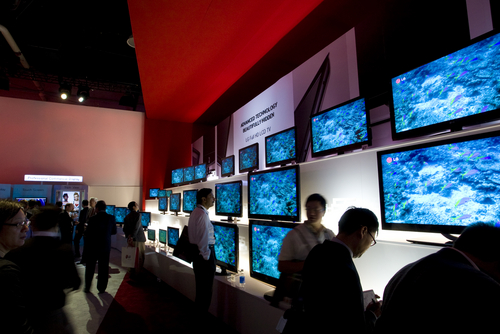Information and analytics provider IHS has released a new iteration of its IHS Semiconductor Spend Analysis report, and it has turned up some interesting findings on the Japanese semiconductor and consumer electronics front, a global market segment that continues to struggle financially. 2012 has not been a good year for the Japanese players in the space.
The major Japanese consumer electronics manufacturers - and in particular Sony and Toshiba - have taken significant hits during the year due to a range of different factors. Chief among them has been a large economic slowdown in key markets of the world, along with much lower than forecasted demand dogging certain product segments. Perhaps even worse, these once dominant players now face increasingly difficult competition from South Korean and Chinese rivals, and especially from Samsung.
According to the latest financial results released by the Japanese vendors - Panasonic, Sony, Toshiba and Sharp - they will all suffer non-trivial losses this year. In fact, as a group, these four companies will see their revenue decline by nearly seven percent in 2012 when compared to 2011.

Image via Shutterstock
Sony, once the absolute gold standard on the consumer electronics front (especially with TVs), looks to be the hardest hit, which continues what has evolved into a steady loss of overall position. Sales estimates for its various products lines including televisions, cameras and gaming devices have been cut significantly for this year. As a result, Sony has needed to issue bonds twice this year because of the ongoing deterioration of its financial position.
Raising those dollars (or yen) has been made doubly difficult for Sony because Moody’s has dropped Sony's credit rating to the lowest possible investment grade. How bad is it for Sony? The company unfortunately finds itself in need of eliminating 10,000 jobs, and will do so by the end of its 2012 fiscal year. It also finds itself in need of selling off assets such as manufacturing plants, as well as shares in joint ventures.
No Better Defense than a Good Offense
Though financials are currently grim, both Sony and Toshiba understand that business cycles are, well, "cyclical." And neither company is about to give up the ghost. Rather they are now putting themselves into position to make deep investments so that they will in turn be in strong positions to take advantage once the business cycle swings back in their favor. The question of course is whether or not the cycle will swing quickly enough for them to grab the next wave or not.
Given the above scenario, IHS notes in its new spending report that though weakened financially both Sony and Toshiba will in fact substantially increase semiconductor spending over the next two years. These investments will be made in a wide range of innovative new products that both companies believe will revitalize their businesses. The IHS report anticipates the following:
Sony next year is expected to purchase $8.4 billion worth of semiconductors, up nearly five percent from $8.0 billion in 2012. Company spending will also rise slightly again the following year by 0.1 percent.
Toshiba’s spending will increase 2.0 percent to $6.1 billion in 2013, up from $6.0 billion in 2012. Toshiba’s spending will surge by another 6.3 percent in 2014, reaching $6.5 billion.
In almost stark contrast, spending at Panasonic and Sharp will decline in 2013 and 2014. Sharp is looking to external sources such as Dell to make large investments in the company, but Panasonic is projected to see a minor rebound of 2.4 percent in 2014.
Myson Robles-Bruce, senior analyst for semiconductor spending and design activity at HIS, notes that, “Even in their grim circumstances, Sony and Toshiba both remain optimistic about the future, and are taking steps to invest in innovative products. This will cause their spending on semiconductors to rise in the coming years.”
IHS predicts that Sony will bounce back with 3.7 percent revenue growth in 2013. However, Toshiba will suffer another one percent decline. Declines in 2013 revenue are expected at Panasonic and Sharp as well. As we noted above, the real question is whether the current downturn will be a long-term trend or if these companies will be able to eventually recover and gain back their once-dominant positions.
Robles-Bruce adds that, “The Japanese consumer electronics companies face a changed marketplace, due to the rising influence of Apple and other competitors that have redefined key product segments or else have simply just taken away share in key areas. Based on the current financial evidence, it appears as though total revenue for Sony might be higher for next year, although estimates for Toshiba actually show a slight decline.”
Future Strategies
IHS says that it found proof that the spirit of innovation is alive and well at Sony and Toshiba at the October 2012 CEATEC, Japan’s version of the Consumer Electronics Shows (CES). Sony demonstrated a wide range of products including smartphones, tablets, PCs, cameras, televisions and home networking and storage equipment. Some of the highlights included the Bravia 4K liquid crystal display television (LCD TV), and new hybrid PCs that can be utilized as either tablets or laptops.
Beyond the CEATEC show, Sony has also indicated that it is developing a new “phablet” handset device. The company is likewise working on its PlayStation 4 game console device, which could be released late next year.
Also at CEATEC, Toshiba showcased its latest products, which included a 4K resolution television. Other featured products included ultrabooks and tablets. Toshiba was able to debut products in small, medium and large screen sizes. Additionally, the company introduced new REGZA HDTVs, which offer built-in DVR capability for time shifting.
The upcoming 2013 CES show in early January in the United States should provide further proof of how Sony and Toshiba will focus their recoveries.
Edited by
Brooke Neuman  QUICK LINKS
QUICK LINKS